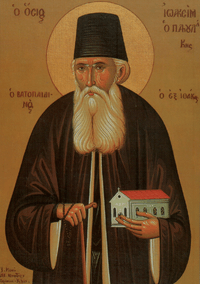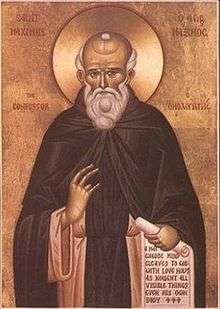March 2 (Eastern Orthodox liturgics)
March 1 - Eastern Orthodox liturgical calendar - March 3
All fixed commemorations below are observed on March 15 by Orthodox Churches on the Old Calendar.[note 1]
For March 2nd, Orthodox Churches on the Old Calendar commemorate the Saints listed on February 17 (February 18 on leap years).
Saints
- Hieromartyrs Nestor the Bishop, and Tribiminus the Deacon, at Perge in Pamphylia (ca. 250)[1][2]
- Martyr Troadius of Neo-Caesarea, and those with him (251)[2][3][4]
- Virgin-martyr Euthalia of Sicily (252)[2][5][6]
- St. Cointus of Phrygia (Quintus of Phrygia), Confessor and Wonderworker (283)[2][7]
- Martyr Hesychius the Senator (the Palatine), of Antioch (ca. 304)[2][8] (see also: May 10)
- Hiero-Confessor Theodotus, Bishop of Cyrenia in Cyprus (c. 326)[2][9][10]
- Venerable Saints Andronicus and the Athanasia (5th century)[11][12][note 2] (see also: October 9)
- Saint Agathon of Egypt, monk (5th century)[2][13]
Pre-Schism Western Saints
- Martyrs of Rome, a large number of martyrs martyred in Rome under Alexander Severus and the prefect Ulpian (219)[14][note 3]
- Saints Jovinus and Basileus, two martyrs who suffered in Rome under Gallienus and Valerian, buried on the Latin Way (258)[14]
- Saints Paul, Heraclius, Secundilla and Januaria, martyrs who suffered under Diocletian at Porto Romano at the mouth of the Tiber in Italy (305)[14]
- Saint Gistilian (Gistlian), uncle of St David and a monk at Menevia, or St Davids, in Wales (5th-6th centuries)[14]
- Saint Joavan, a Romano-Briton who went to Brittany to live with his uncle St Paul of Léon, by whom he was consecrated bishop (ca. 570)[14][note 4]
- 440 Martyrs slain by the Lombards in Italy (Martyrs of Campania) (ca. 579)[2][14][17][note 5]
- Saint Fergna, called 'the White', a relative and disciple of St Columba of Ireland, Abbot of Iona (637)[14]
- Saint Chad (Ceadda), Bishop of Lichfield (England) (672)[2][14][19]
- Saint Cynibil (Cynibild), a brother of Sts Chad and Cedd who helped enlighten England (7th century)[14]
- Saint Willeic, a disciple of St Swithbert who made him Abbot of Kaiserwerth in Germany (726)[14]
- Saint Slebhene (Sléibíne mac Congaile), a monk from Ireland, he became Abbot of Iona in Scotland (767)[14]
Post-Schism Orthodox Saints
- Venerable Arsenius, Bishop of Tver (1409)[2][20][21]
- Venerable Sabbatius, monk of Tver (1434),[22] and his disciple St. Euphrosynus (1460)[23][2][24]
- Venerable Barsanuphius (1459) and Sabbas (1467), abbots of Tver.[25][2][24]
- Venerable Abramios of Spassk, of the monastery of Christ the Saviour, Russia (16th century)[26]
- New Martyr Theodore Sladić of Komogovina (1788)[2][12][note 6]
- Venerable Joachim (Papoulakis) of Ithaca, monk of Vatopedi (Mt. Athos) and Ithaca (1868)[2][12][28]
- Saint Ambrose (Khelaia) the Confessor, Catholicos-Patriarch of All Georgia (1927)[29](see also: March 16 and March 27)
- Saint Nicholas Planas of Athens (1932)[12][30][note 7] (see also: February 17 - Slavonic)
Other Commemorations
Icon Gallery
 Venerable Joachim (Papoulakis) of Ithaca.
Venerable Joachim (Papoulakis) of Ithaca..jpg) Ambrosius, Catholicos-Patriarch of All Georgia.
Ambrosius, Catholicos-Patriarch of All Georgia..jpg) Saint Nicholas Planas of Athens (1851–1932).
Saint Nicholas Planas of Athens (1851–1932).
Notes
- ↑ The notation Old Style or (OS) is sometimes used to indicate a date in the Julian Calendar (which is used by churches on the "Old Calendar").
The notation New Style or (NS), indicates a date in the Revised Julian calendar (which is used by churches on the "New Calendar"). - ↑ Saints Andronikos and Athanasia were virtuous spouses, who came from Antioch in Syria. St. Andronikos' profession was that of a money-changer, and his spouse lived always according to God. The wealth that the Lord had granted them did not fill their hearts with pride and conceit. They had two children by their marriage, however both of them died. This grieved the Saints greatly, who thereafter sought solace on their pilgrimage to the Holy Land. From there they arrived in Egypt, where they both agreed to become monastics. The Venerable Andronikos went to the monastery of Abba Daniel, and the Blessed Athanasia to the Convent of Tabennisi. They feel asleep in peace.
- ↑ "Also at Rome, under the emperor Alexander, and the prefect Ulpian, many holy martyrs, who were a long time tortured, and then condemned to capital punishment."[15]
- ↑ "ST. JOAVAN is said to have been a native of Ireland, and to have professed the religious state at Landevenic, in Brittany. He went, however, to Great Britain and became the disciple of St. Paul, afterwards Bishop of Leon. When the latter Saint went over to Brittany, Joavan accompanied him, and in time became his coadjutor and successor in the diocese of Leon. When released from his charge by a holy death, his body was conveyed to a place called Plougen, and buried under a tomb, which may still be seen there. This sepulchre is held in great veneration by the people, but the sacred relics have disappeared and can nowhere be traced. There are two parishes dedicated to St. Joavan, and he is venerated in other parts of Upper Brittany. His festival is kept on the 2nd March."[16]
- ↑ "In their ravages about the year 597, they attempted to compel forty husbandmen, whom they had made captives, to eat meats which had been offered to idols. The faithful servants of Christ constantly refusing to comply, were all massacred. Such meats might, in some circumstances, have been eaten without sin, but not when this was exacted out of a motive of superstition. The same barbarians endeavoured to oblige another company of captives to adore the head of a goat, which was their favourite idol, and about which they walked, singing, and bending their knees before it; but the Christians chose rather to die than purchase their lives by offending God. They are said to have been about four hundred in number."[18]
- ↑ He is remembered on Theodore's Saturday (Тодорова субота), which falls on the first Saturday of Great Lent.[27]
- ↑ His feast day is celebrated on March 2, except when it falls during Great Lent period; then it is celebrated on the first Sunday following March 2. As a local saint of Paronaxia, he is also celebrated on the first Sunday of September, as part of the celebration of the island's five key saints at the Church of St. Nikodemus of the Holy Mountain on the island of Naxos in Greece.
References
- ↑ Great Synaxaristes: (in Greek) Οἱ Ἅγιοι Νέστωρ καὶ Τριβιμίνος οἱ Μάρτυρες. 2 ΜΑΡΤΙΟΥ. ΜΕΓΑΣ ΣΥΝΑΞΑΡΙΣΤΗΣ.
- 1 2 3 4 5 6 7 8 9 10 11 12 13 14 15 16 March 2/March 15. Orthodox Calendar (PRAVOSLAVIE.RU).
- ↑ Great Synaxaristes: (in Greek) Ὁ Ἅγιος Τρωάδιος ὁ Μάρτυρας. 2 ΜΑΡΤΙΟΥ. ΜΕΓΑΣ ΣΥΝΑΞΑΡΙΣΤΗΣ.
- ↑ Martyr Troadius of Neocaesarea. OCA - Lives of the Saints.
- ↑ Great Synaxaristes: (in Greek) Ἡ Ἁγία Εὐθαλία ἡ Παρθενομάρτυς. 2 ΜΑΡΤΙΟΥ. ΜΕΓΑΣ ΣΥΝΑΞΑΡΙΣΤΗΣ.
- ↑ Virginmartyr Euthalia of Sicily. OCA - Lives of the Saints.
- ↑ Great Synaxaristes: (in Greek) Ὁ Ἅγιος Κοΐντος ὁ Μάρτυρας Ὁμολογητὴς καὶ Θαυματουργὸς. 2 ΜΑΡΤΙΟΥ. ΜΕΓΑΣ ΣΥΝΑΞΑΡΙΣΤΗΣ.
- ↑ Great Synaxaristes: (in Greek) Ὁ Ἅγιος Ἡσύχιος ὁ Συγκλητικὸς. 2 ΜΑΡΤΙΟΥ. ΜΕΓΑΣ ΣΥΝΑΞΑΡΙΣΤΗΣ.
- ↑ Great Synaxaristes: (in Greek) Ὁ Ἅγιος Θεόδοτος ὁ Ἱερομάρτυρας Ἐπίσκοπος Κυρηνείας Κύπρου. 2 ΜΑΡΤΙΟΥ. ΜΕΓΑΣ ΣΥΝΑΞΑΡΙΣΤΗΣ.
- ↑ Hieromartyr Theodotus the Bishop of Cyrenia. OCA - Lives of the Saints.
- ↑ Great Synaxaristes: (in Greek) Οἱ Ἅγιοι Ἀνδρόνικος καὶ Ἀθανασία. 2 ΜΑΡΤΙΟΥ. ΜΕΓΑΣ ΣΥΝΑΞΑΡΙΣΤΗΣ.
- 1 2 3 4 March 15 / March 2. HOLY TRINITY RUSSIAN ORTHODOX CHURCH (A parish of the Patriarchate of Moscow).
- ↑ Venerable Agathon of Egypt. OCA - Lives of the Saints.
- 1 2 3 4 5 6 7 8 9 10 11 March 2. Latin Saints of the Orthodox Patriarchate of Rome.
- ↑ The Roman Martyrology. Transl. by the Archbishop of Baltimore. Last Edition, According to the Copy Printed at Rome in 1914. Revised Edition, with the Imprimatur of His Eminence Cardinal Gibbons. Baltimore: John Murphy Company, 1916. p. 63.
- ↑ Rev. Richard Stanton. A Menology of England and Wales, or, Brief Memorials of the Ancient British and English Saints Arranged According to the Calendar, Together with the Martyrs of the 16th and 17th Centuries. London: Burns & Oates, 1892. p. 95.
- ↑ 440 Martyrs slain by the Lombards in Sicily. OCA - Lives of the Saints.
- ↑ Rev. Alban Butler. "March 2: Martyrs under the Lombards." The Lives of the Fathers, Martyrs, and Other Principal Saints, Volume III: March. Dublin: James Duffy, 1866. New York: Bartleby.com, 2010.
- ↑ Great Synaxaristes: (in Greek) Ὁ Ἅγιος Τσὰντ ἐκ Σκωτίας. 2 ΜΑΡΤΙΟΥ. ΜΕΓΑΣ ΣΥΝΑΞΑΡΙΣΤΗΣ.
- ↑ Great Synaxaristes: (in Greek) Ὁ Ἅγιος Ἀρσένιος Ἐπίσκοπος Τβὲρ τῆς Ρωσίας. 2 ΜΑΡΤΙΟΥ. ΜΕΓΑΣ ΣΥΝΑΞΑΡΙΣΤΗΣ.
- ↑ St Arsenius the Bishop of Tver. OCA - Lives of the Saints.
- ↑ St Sabbatius of Tver. OCA - Lives of the Saints.
- ↑ The Monk Evphrosyn. HOLY TRINITY RUSSIAN ORTHODOX CHURCH (A parish of the Patriarchate of Moscow).
- 1 2 Great Synaxaristes: (in Greek) Οἱ Ὅσιοι Βαρσανούφιος, Σάββας, Σαββάτιος καὶ Εὐφρόσυνος ἐκ Ρωσίας. 2 ΜΑΡΤΙΟΥ. ΜΕΓΑΣ ΣΥΝΑΞΑΡΙΣΤΗΣ.
- ↑ The Monks Varsonophii and Savva of Tver'. HOLY TRINITY RUSSIAN ORTHODOX CHURCH (A parish of the Patriarchate of Moscow).
- ↑ Great Synaxaristes: (in Greek) Ὁ Ὅσιος Ἀβράμιος ἐκ Ρωσίας. 2 ΜΑΡΤΙΟΥ. ΜΕΓΑΣ ΣΥΝΑΞΑΡΙΣΤΗΣ.
- ↑ Celebration of Theodore's Saturday at Belgrade Seminary. The Information Service of the Serbian Orthodox Church
- ↑ Great Synaxaristes: (in Greek) Ὁ Ὅσιος Ἰωακεὶμ ὁ Ἰθακήσιος. 2 ΜΑΡΤΙΟΥ. ΜΕΓΑΣ ΣΥΝΑΞΑΡΙΣΤΗΣ.
- ↑ Great Synaxaristes: (in Greek) Ὁ Ἅγιος Ἀμβρόσιος Πατριάρχης Γεωργίας. 2 ΜΑΡΤΙΟΥ. ΜΕΓΑΣ ΣΥΝΑΞΑΡΙΣΤΗΣ.
- ↑ Great Synaxaristes: (in Greek) Ὁ Ἅγιος Νικόλαος ὁ Πλανᾶς. 2 ΜΑΡΤΙΟΥ. ΜΕΓΑΣ ΣΥΝΑΞΑΡΙΣΤΗΣ.
- ↑ Great Synaxaristes: (in Greek) Σύναξις Ὑπεραγίας Θεοτόκου τῆς Ἐνθρόνου. 2 ΜΑΡΤΙΟΥ. ΜΕΓΑΣ ΣΥΝΑΞΑΡΙΣΤΗΣ.
- ↑ Icon of the Mother of God “Enthroned”. OCA - Lives of the Saints.
Sources
- March 2/March 15. Orthodox Calendar (PRAVOSLAVIE.RU).
- March 15 / March 2. HOLY TRINITY RUSSIAN ORTHODOX CHURCH (A parish of the Patriarchate of Moscow).
- March 2. OCA - The Lives of the Saints.
- Dr. Alexander Roman. March. Calendar of Ukrainian Orthodox Saints (Ukrainian Orthodoxy - Українське Православ'я).
- The Autonomous Orthodox Metropolia of Western Europe and the Americas (ROCOR). St. Hilarion Calendar of Saints for the year of our Lord 2004. St. Hilarion Press (Austin, TX). p. 19.
- March 2. Latin Saints of the Orthodox Patriarchate of Rome.
- The Roman Martyrology. Transl. by the Archbishop of Baltimore. Last Edition, According to the Copy Printed at Rome in 1914. Revised Edition, with the Imprimatur of His Eminence Cardinal Gibbons. Baltimore: John Murphy Company, 1916. p. 63.
- Rev. Richard Stanton. A Menology of England and Wales, or, Brief Memorials of the Ancient British and English Saints Arranged According to the Calendar, Together with the Martyrs of the 16th and 17th Centuries. London: Burns & Oates, 1892. pp. 95-98.
Greek Sources
- Great Synaxaristes: (in Greek) 2 ΜΑΡΤΙΟΥ. ΜΕΓΑΣ ΣΥΝΑΞΑΡΙΣΤΗΣ.
- (in Greek) Συναξαριστής. 2 Μαρτίου. ECCLESIA.GR. (H ΕΚΚΛΗΣΙΑ ΤΗΣ ΕΛΛΑΔΟΣ).
Russian Sources
- (in Russian) 15 марта (2 марта). Православная Энциклопедия под редакцией Патриарха Московского и всея Руси Кирилла (электронная версия). (Orthodox Encyclopedia - Pravenc.ru).
- (in Russian) 2 марта (ст.ст.) 15 марта 2013 (нов. ст.). Русская Православная Церковь Отдел внешних церковных связей. (DECR).
This article is issued from
Wikipedia.
The text is licensed under Creative Commons - Attribution - Sharealike.
Additional terms may apply for the media files.

